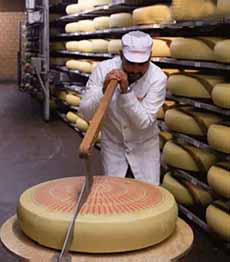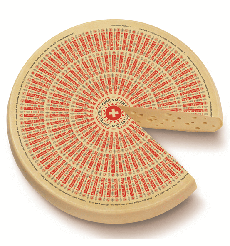Types Of Emmental, The Real “Swiss Cheese”
|
The U.S. is not known for its food sophistication, knowledge, or accuracy. Errors surround the most popular foods. Today’s focus is one of them, “Swiss cheese.”
There is no Swiss product called “Swiss cheese,” just as there is no “French cheese,” “Italian cheese,” and so forth. It’s a generic reference, like “French wine” or “Italian wine.” (Yes, there is Swiss wine, but you have to go there to try it. Nearly all is drunk domestically, with less than 2% exported, mainly to Germany.) Swiss cheese is the generic name used in the United States for several related varieties of cheese, originally made in Switzerland. Emmentaler is the cheese Americans think of as the generic Swiss cheese. While Americans believe that Swiss cheese has holes, properly known as eyes, not all kinds of Swiss cheese do. There are 450 known Swiss cheeses, classified into five categories: extra-hard, hard, semi-hard, semi-soft and soft. Cow’s milk is used in 99% of the cheeses produced. Examples include: The Swiss cheese variety with the big eyes—the holes—is Emmental, also spelled Emmentaler, Emmenthal or Emmenthaler, and pronounced without the “h” (i.e., em-en-TAL, em-en-TAL-er). You may want to pick some up for tomorrow, National Cheeseburger Day. But today, we’ll focus on the glories of Emmental. Flavorful and imposing in size, the Swiss consider Emmental to be the king of the Swiss cheeses. It takes its name from the valley of the river Emme, in the canton of Bern*, also the home of Bern, the capital city of Switzerland. Emmental cheese production traces its origins to the 13th century. Emmentaler AOC is produced by some 200 dairies, from the fresh, raw milk of cows fed on valley grass. The milk accounts for the superior flavor of Emmenthal versus American reproductions: The milk from American factory cheeses (as opposed to artisan cheeses) typically comes from feedlot cows, who don’t graze and are fed commercial feed. Their milk does not have the flavor of milk from cows who graze on grass. Swiss milk is also rBgh/rBst-free, and genetically modified ingredients and any additives are forbidden. Around 12 liters (12.6 quarts) of milk are needed to produce one kilo (2.2 pounds) of cheese. The round wheels of cheese have a diameter of 80 to 100 centimeters (31-39 inches—that’s more than three feet wide!), and weigh in at 75 to 120 kg (163-265 pounds). Yes, they’re heavy lifting. The taste and texture differentiate quality Emmental from rubbery American imitations. While other Swiss mountain cheeses have eyes, Emmental has the largest. The holes range from cherry size to walnut size. The eyes develop from the bacteria used in the production of Emmentaler cheese: Streptococcus thermophilis, Lactobacillus and Propionibacter shermani. In a late stage of cheese production, P. shermani consumes the lactic acid excreted by the other two bacteria, and releases carbon dioxide gas. This forms the bubbles that appear to be “holes” when the cheese is sliced. The cheese industry calls these holes or tunnels “eyes.” Swiss cheese without eyes is known as “blind.” |
|
|
|
TYPES OF EMMENTAL & HOW TO USE THEM Emmentaler AOC is sold in different stages of maturity, for different culinary purposes and palates. The original starter culture for Emmental was brought from Switzerland to Wisconsin in the 1850s, by immigrant Swiss cheesemakers, who recreated the cheese from their homeland. The American version of Emmentaler became known as “Swiss” cheese by the locals—perhaps because “Swiss” was easier to say than “Emmental.” |
||
|
Alas. ________________ *A canton is analogous to an American state. There are 26 cantons in Switzerland. †Also called Alpine cheeses, the term “mountain cheeses” refers to large, firm wheels made in the Swiss mountains (the Alps). These wheels are well-aged and full-flavored, often sprinkled with holes (some quite small). Appenzeller, Emmental, Gruyère, Hoch Ybrig, Raclette (four different cheeses), Sbrinz, Stanser Fladä, Tête de Moine and Vacherin Fribourgeois are examples. Mountain cheeses are not restricted to Switzerland, but to any mountains. Here’s more about mountain cheese.
|
||







